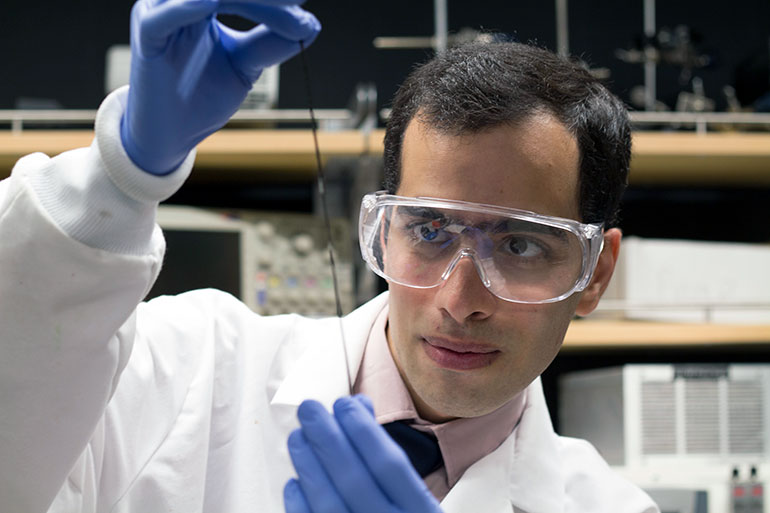
UBC doctoral student Hossein Montazerian takes a close look at a tiny sensor embedded into a fibre.
Device will impact composites manufacturing and health-monitoring industries
Forget the smart watch. Bring on the smart shirt.
Researchers at UBC Okanagan’s School of Engineering have developed a low-cost sensor that can be interlaced into textiles and composite materials. While the research is still new, the sensor may pave the way for smart clothing that can monitor human movement.
The embedded microscopic sensor is able to recognize local motion through the stretching of the woven yarns that are treated with graphene nanoplatelets that can read the body’s activity, explains Engineering Professor Mina Hoorfar.
“Microscopic sensors are changing the way we monitor machines and humans,” says Hoorfar, lead researcher at the Advanced Thermo-Fluidic Lab at UBC’s Okanagan campus. “Combining the shrinking of technology along with improved accuracy, the future is very bright in this area.”
This ‘shrinking technology’ uses a phenomenon called piezo-resistivity—an electromechanical response of a material when it is under strain. These tiny sensors have shown a great promise in detecting human movements and can be used for heart rate monitoring or temperature control, explains Hoorfar.
Her research, conducted in partnership with UBC Okanagan’s Materials and Manufacturing Research Institute, shows the potential of a low-cost, sensitive and stretchable yarn sensor. The sensor can be woven into spandex material and then wrapped into a stretchable silicone sheath. This sheath protects the conductive layer against harsh conditions and allows for the creation of washable wearable sensors.
While the idea of smart clothing—fabrics that can tell the user when to hydrate, or when to rest—may change the athletics industry, UBC Professor Abbas Milani says the sensor has other uses. It can monitor deformations in fibre-reinforced composite fabrics currently used in advanced industries such as automotive, aerospace and marine manufacturing.
The low-cost stretchable composite sensor has also shown a high sensitivity and can detect small deformations such as yarn stretching as well as out-of-plane deformations at inaccessible places within composite laminates, says Milani, director of the UBC Materials and Manufacturing Research Institute.
The testing indicates that further improvements in its accuracy could be achieved by fine-tuning the sensor’s material blend and improving its electrical conductivity and sensitivity This can eventually make it able to capture major flaws like “fibre wrinkling” during the manufacturing of advanced composite structures such as those currently used in airplanes or car bodies.
“Advanced textile composite materials make the most of combining the strengths of different reinforcement materials and patterns with different resin options,” he says. “Integrating sensor technologies like piezo-resistive sensors made of flexible materials compatible with the host textile reinforcement is becoming a real game-changer in the emerging era of smart manufacturing and current automated industry trends.”
The research, published recently in Small was conducted by researchers at the Composites Research Network and the Advanced Thermo-Fluidic Lab with funding from the Natural Sciences and Engineering Research Council.
About UBC's Okanagan campus
UBC’s Okanagan campus is an innovative hub for research and learning in the heart of British Columbia’s stunning Okanagan Valley. Ranked among the top 20 public universities in the world, UBC is home to bold thinking and discoveries that make a difference. Established in 2005, the Okanagan campus combines a globally recognized UBC education with a tight-knit and entrepreneurial community that welcomes students and faculty from around the world.
To find out more, visit: ok.ubc.ca.
 ICBC warns teens for prom
ICBC warns teens for prom 44-year-old woman missing
44-year-old woman missing Stanley Cup Playoff etiquette
Stanley Cup Playoff etiquette Senators reject field trip
Senators reject field trip 'City within a city'
'City within a city' Searching landfill for woman
Searching landfill for woman Israeli strike played down
Israeli strike played down Full Trump jury seated
Full Trump jury seated World's largest election
World's largest election  Lululemon cuts 100 jobs
Lululemon cuts 100 jobs Bitcoin's 'halving' arrives
Bitcoin's 'halving' arrives Lawsuit over missing nuts
Lawsuit over missing nuts Warriors ready for Round 2
Warriors ready for Round 2 Kalamalka Bowl cancelled
Kalamalka Bowl cancelled Rockets live to fight on
Rockets live to fight on Pulp Fiction turns 30
Pulp Fiction turns 30 Chris Pratt injured in movie
Chris Pratt injured in movie My name is not Elaine
My name is not Elaine


